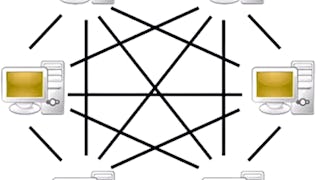Understand how QoS is used in managing data flows to handle network congestion.

Bringen Sie Ihre Karriere in diesem Sommer in Schwung mit Kursen von Google, IBM und anderen für £190/Jahr. Jetzt sparen.


Managing Network Traffic with QoS
Dieser Kurs ist Teil von Spezialisierung Implementing Cisco Quality of Service

Dozent: Cisco Learning & Certifications
Bei  enthalten
enthalten
Was Sie lernen werden
Understand hardware and software queuing and how to manage congestion using link efficiency mechanisms to collectively improve bandwidth efficiency
Explain the problems resulting from TCP flow control limitations on a converged network and how RED can prevent congestion in a TCP/IP network
Explain traffic policing and traffic shaping
Kompetenzen, die Sie erwerben
- Kategorie: Network Administration
- Kategorie: TCP/IP
- Kategorie: Network Performance Management
- Kategorie: Telecommunications
- Kategorie: Network Protocols
- Kategorie: Wide Area Networks
- Kategorie: Algorithms
- Kategorie: Service Level
- Kategorie: Network Switches
- Kategorie: Network Routing
Wichtige Details

Zu Ihrem LinkedIn-Profil hinzufügen
Juli 2025
21 Aufgaben
Erfahren Sie, wie Mitarbeiter führender Unternehmen gefragte Kompetenzen erwerben.

Erweitern Sie Ihre Fachkenntnisse
- Lernen Sie neue Konzepte von Branchenexperten
- Gewinnen Sie ein Grundverständnis bestimmter Themen oder Tools
- Erwerben Sie berufsrelevante Kompetenzen durch praktische Projekte
- Erwerben Sie ein Berufszertifikat zur Vorlage

In diesem Kurs gibt es 5 Module
Das ist alles enthalten
2 Lektüren
Aggressive traffic can fill interface queues and starve more fragile flows such as voice, video, and interactive traffic. The results can be devastating for delay-sensitive traffic types, making it difficult to meet the service-level requirements that these applications require. There are many congestion management techniques available on Cisco platforms that can provide you with an effective means to manage software queues and to allocate the required bandwidth to specific applications when congestion exists. Upon completing this learning content, you will be able to: • Describe the functions of hardware and software queuing and various commonly used queuing algorithms. • Configure Weighted Fair Queuing (WFQ) to manage congestion. • Configure Class-Based Weighted Fair Queuing (CBWFQ) and low latency queuing (LLQ) to manage congestion. • Describe campus-based techniques to manage congestion.
Das ist alles enthalten
13 Lektüren5 Aufgaben
Congestion is a normal occurrence in networks. Whether congestion occurs as a result of a lack of buffer space, network aggregation points, or a low-speed wide-area link, many congestion management techniques exist to ensure that specific applications and traffic classes are given their share of available bandwidth when congestion occurs. When congestion occurs, some traffic is delayed or even dropped at the expense of other traffic. When drops occur, different problems may arise that can exacerbate the congestion, such as retransmissions and TCP global synchronization in TCP/IP networks. Network administrators can use congestion avoidance mechanisms to reduce the negative effects of congestion by penalizing the most aggressive traffic streams as software queues begin to fill.
Das ist alles enthalten
12 Lektüren5 Aufgaben
Different forms of connectivity within a network can have significantly different costs for an organization. Because WAN bandwidth is relatively expensive, many organizations would like to limit the amount of traffic that specific applications can send. This is especially true when enterprise networks use internet connections for connectivity to remote sites and the extranet. Downloading nonbusiness-critical images, music, and movie files can significantly reduce the amount of bandwidth that is available for mission-critical applications. Traffic policing and traffic shaping are two quality of service (QoS) techniques that can limit the amount of bandwidth that a specific application, user, or class of traffic can use on a link. Upon completing this course, you will be able to: • Explain how traffic policing and traffic shaping can be used to rate-limit traffic. • Configure class-based policing to rate-limit traffic. • Describe the implementation options that are available for traffic policing in the campus. • Configure class-based shaping to rate-limit traffic. • Given a Frame Relay WAN link, configure class-based shaping to rate-limit traffic. • Given a Frame Relay WAN link, configure the Frame Relay Voice-Adaptive Traffic Shaping and Fragmentation feature to improve the performance of voice transport.
Das ist alles enthalten
23 Lektüren7 Aufgaben
In a network that consists of a large WAN covering many sites, the monthly recurring cost of even the smallest link upgrade can be too high. In some cases, the only option for low-bandwidth remote sites is to upgrade their wide-area circuit. In other cases, a set of quality of service (QoS) techniques can be used to improve the efficiency of these low-speed WAN links, which, in this context, typically refer to links with speeds less than or equal to 768 kb/s. Header compression and payload compression mechanisms reduce the sizes of packets, reducing delay and increasing available bandwidth on a link. Other QoS link efficiency techniques, such as link fragmentation and interleaving (LFI), allow fragile traffic types, such as voice and interactive traffic, to be sent either ahead or interleaved with larger, more aggressive flows. These techniques decrease latency and assist in meeting the service-level requirements of delay-sensitive traffic types such as voice.
Das ist alles enthalten
11 Lektüren4 Aufgaben
Erwerben Sie ein Karrierezertifikat.
Fügen Sie dieses Zeugnis Ihrem LinkedIn-Profil, Lebenslauf oder CV hinzu. Teilen Sie sie in Social Media und in Ihrer Leistungsbeurteilung.
Dozent

Mehr von Networking entdecken
 Status: Kostenloser Testzeitraum
Status: Kostenloser TestzeitraumUniversity of Colorado System

Google Cloud
 Status: Kostenloser Testzeitraum
Status: Kostenloser TestzeitraumIllinois Tech

Google Cloud
Warum entscheiden sich Menschen für Coursera für ihre Karriere?





Neue Karrieremöglichkeiten mit Coursera Plus
Unbegrenzter Zugang zu 10,000+ Weltklasse-Kursen, praktischen Projekten und berufsqualifizierenden Zertifikatsprogrammen - alles in Ihrem Abonnement enthalten
Bringen Sie Ihre Karriere mit einem Online-Abschluss voran.
Erwerben Sie einen Abschluss von erstklassigen Universitäten – 100 % online
Schließen Sie sich mehr als 3.400 Unternehmen in aller Welt an, die sich für Coursera for Business entschieden haben.
Schulen Sie Ihre Mitarbeiter*innen, um sich in der digitalen Wirtschaft zu behaupten.
Häufig gestellte Fragen
Access to lectures and assignments depends on your type of enrollment. If you take a course in audit mode, you will be able to see most course materials for free. To access graded assignments and to earn a Certificate, you will need to purchase the Certificate experience, during or after your audit. If you don't see the audit option:
The course may not offer an audit option. You can try a Free Trial instead, or apply for Financial Aid.
The course may offer 'Full Course, No Certificate' instead. This option lets you see all course materials, submit required assessments, and get a final grade. This also means that you will not be able to purchase a Certificate experience.
When you enroll in the course, you get access to all of the courses in the Specialization, and you earn a certificate when you complete the work. Your electronic Certificate will be added to your Accomplishments page - from there, you can print your Certificate or add it to your LinkedIn profile. If you only want to read and view the course content, you can audit the course for free.
If you subscribed, you get a 7-day free trial during which you can cancel at no penalty. After that, we don’t give refunds, but you can cancel your subscription at any time. See our full refund policy.
Weitere Fragen
Finanzielle Unterstützung verfügbar,

